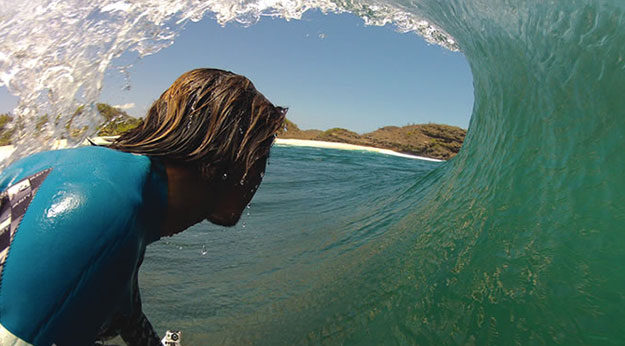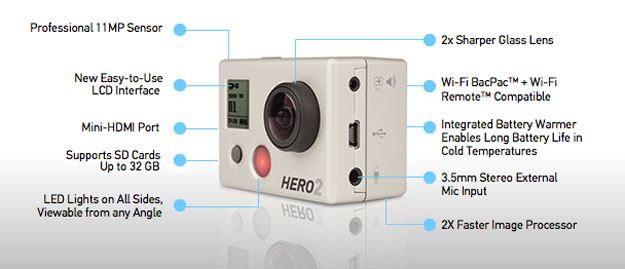Affordable, compact, and easy to use, this little tool has become ubiquitous on the noses of kooks’ surfboards around the world. While we’ve all seen or participated in Youtube videos of jaw-clenching, scratching and surfing reminiscent of spastic action figures, the Go Pro has also enabled athletes to become filmmakers and photographers. This is a paradigm shift that I believe will have lasting repercussions. So when Go Pro announced its new version of the Hero HD was “2X More Powerful in Every Way” we were excited. After digging into the tech specs and hearing from reputable sources the touted features were largely what they were claimed to be, we decided to share our take on this new tool. After all, the original Hero HD was arguably, along with the DSLR, the most impactful piece of technology action-based filmmaking had seen since the rise of video. Although we were hoping for 60fps 1080p and the 120fps is only Standard Def, there are a lot of game changers with this camera.

THE GAME CHANGERS
1) The professional 11MP sensor capable of taking a burst of ten stills per second with a class ten card will likely flood editorial staffs around the world with high quality POV and close-to-action images. This might be bad news for many photographers, especially professional water surf photogs who’ve already seen competition in their market skyrocket from previous technologies. Soon any surfer or person comfortable in the impact zone can swim out and capture a flurry of professional images for the purposes of web and print applications.
2) The adjustable field of view (shoots as narrow as 90º) and 3.5mm microphone jack opens up this camera to documentary filmmakers. While filmmakers have been using Go Pros for creative shots in hard to reach places for a while now, with the LCD back attachment a person can compose shots that aren’t ultra-wide and also record interviews. This said, setbacks remain – it’s likely some barrel distortion caused by the fisheye lens will need to be combated in post-production, the microphone only works outside of the housing, rendering the unit vulnerable to scratching and damage. At this point, we don’t know if the audio has Auto Control Gain, a feature that plagues many DSLRs by causing the audio levels to behave erratically. Despite these potential problems, this will still be a great tool for investigative journalism or any situation where keeping a low profile is paramount.
3) The WiFi controllable options reported by Go Pro will have a huge effect on remote control video and photo capture. The Go Pro has already been the camera of choice for the new era multi-bladed copters that have the ability to mimic stable helicopter aerial shots for pennies on the dollar (provided there’s no wind). But up until now a professional rig has required many hacks like a “nanny cam” to monitor camera POV during flight. Now a person will be able to rock up to wherever the action is, breakout his or her RC copter rig, affix a Go Pro and whip out their iPhone. The adjustable FOV will also address many RC enthusiasts’ gripes regarding the ultra-wide nature of its image.
4) The 11MP stills in time-lapse mode will result in higher quality time-lapses and allow filmmakers to apply pans and zooms in post-production.
5) The 3D Capabilities of the previous Hero will be passed to version 2 because the inputs and camera size have remained the same. Some DIY filmer out there would be wise to create a rig that holds two cameras at the correct spacing to achieve 3d without the use of the housing thus allowing the usage of the mic port. This would allow the capture of sound during 3d filming, something not possible now. This could, however, be a moot point if the audio is subject to “ACG,” in which case a separate audio recording device synched with PluralEyes or similar software would be the go.
Confirmed New Features
– Professional 11MP Sensor
– 2x Faster Image Processor
– 2X Sharper Glass Lens
– Adjustable Field of View- Full 170º, Medium 127º, Narrow 90º in 1080p and 720p Video
– 120 fps WVGA (Standard Def), 48 fps 960p (Still includes 60fps 720p)
– 10 11MP Photos Per Second Burst
– 1 11MP Photo Every 0.5 Sec Time-lapse Mode
– 3.5mm External Stereo Microphone Input
– User Interface: A menu that makes sense! No need for the manual
– Remote recording and playback via app on phone or iPad

Questions and Room for Improvement
As mentioned earlier, there is no 60fps at 1080p and the 120 fps is at Standard Def. Also the small censor size still requires plenty of light to perform its duty without considerable grain. There is a noticeably higher amount of saturation, which looks nice but ultimately doesn’t matter if you are in the habit of adjusting your colors in post. Perhaps the biggest question remaining about the new Hero is its Megabyte per Second Data Rate. An often overlooked specification, this is perhaps the most important aspect of a camera’s potential performance. The reason the Go Pro has kicked the crap out of other POV competitors is because of its relatively high “mbps” data rate. At a lower “mbps” rate footage starts to break apart into mosaic patterns with rapid changes to the scene (as is common in outdoor and high action situations). The Go Pro’s relatively clean image at slow motion compared to other POV cameras, yet more much pixelated images when compared to a DSLR can be attributed to its middle of the road mbps processing. It’s interesting that Go Pro didn’t include these figures in its tech specs like it has for all previous cameras. Could it be because they are not “2X More Powerful?” We’ll see.
The price comes in at $299 bumping the Original Surf Hero to $229. Should you buy it? If you’ve already pushed the Hero 1 to the limits of its video potential or want a compact, waterproof photo solution then yes, you should. If you want to get it because you think the “2X Sharper Lens,” or the more saturated colors will give you better looking video, then save your money for a good wetsuit. The lens was always sufficient for its resolution of video and you can always tweak the colors in your editing program.
For more from Cyrus, check out the Dispensers of DIY, Digital Aloha over at Korduroy.tv

